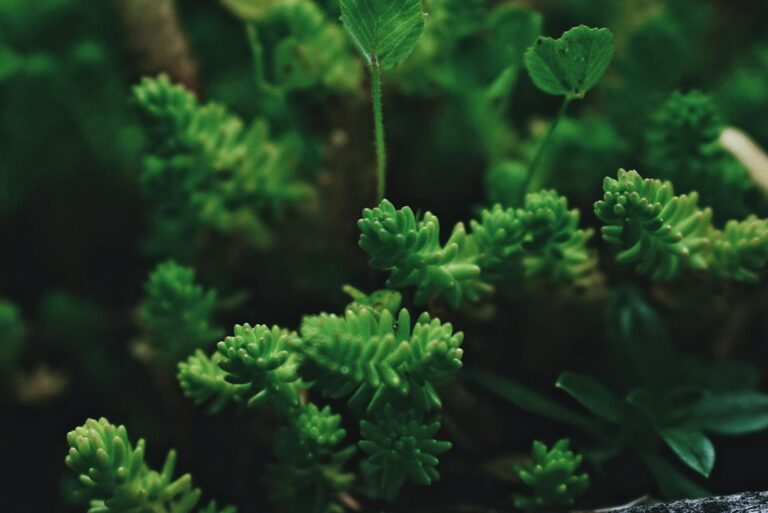Introduction to Sedum and Lawn Grass Dynamics
Imagine a game of tug-of-war, where each team is equally strong and determined: that’s quite the battle! Now, picture your garden as the battleground, with sedum, a vigorous groundcover, on one side and your tried-and-true lawn grass on the other. Curious about who’ll come out on top? Well, that’s what we’re here to explore! But first, let’s set the scene with a real-life example: Ms. Green Thumb, a passionate gardener, noticed a patch of sedum slowly creeping into her pristine turf. She marveled at the sedum’s resilience but worried about her lawn’s fate. Could this be the future of her garden? A takeover? Let’s delve deeper into this vegetative drama.

The crux of the matter lies in understanding the growth habits of these two plant types. Sedum, with its succulent, hardy nature, can be quite the competitor against grass, especially under certain conditions. When the soil’s dry and the sun’s relentless, sedum might just have the upper hand with its drought-resistant superpowers. On the flip side, grass tends to prefer a lusher, more irrigated environment – your classic suburban lawn, perhaps?
Spotlighting Ms. Green Thumb’s predicament, we find that our gardening aficionado had a rather sunny and dry patch where the sedum showed its ambitions. The grass there wasn’t quite as happy, and the sedum sensed an opportunity to thrive. This observation raises an important question: How can gardeners maintain balance in such diverse plant ecosystems?
It’s essential to acknowledge that while sedum can be assertive, it’s not always the unruly garden guest it’s made out to be. The interplay between sedum and lawn grass is a classic example of plant dynamics, where the environment often dictates the victor. While Ms. Green Thumb might need to keep an eye on her verdant invaders, understanding their requirements and behaviors is key to ensuring that neither the sedum oversteps its bounds nor the grass wilts away in defeat.
To maintain that peaceful coexistence, it might be wise to consider their differing needs. For instance, strategic placement of sedum in those hard-to-water spots could be the clever garden hack Ms. Green Thumb needs, leaving the thirstier grass to the more pampered parts of the lawn. And by understanding their unique qualities and growth patterns, one can cultivate a harmonious space that gratifies both the beauty of sedum and the classic charm of a green lawn.
Characteristics of Sedum That Fuel Its Spread
Drought Tolerance: Sedum, a hardy succulent, thrives in conditions that would leave other plants wilting. Picture a parched landscape, where every blade of grass yearns for a drop of water. Amidst this thirsty backdrop, sedum stands out—its plump, moisture-storing leaves unbothered by the drought. This innate resilience means it can easily colonize areas where grass struggles to survive, creating an emerald carpet that defies the arid climate.
Low Maintenance: In the hustle of our daily lives, low-maintenance gardening is a blessing. Sedum demands very little; it asks not for the dedicated nurturing that grass does. There’s no need for constant watering, frequent trimming, or the vigilance against pests. Instead, sedum spreads with casual grace, quietly weaving its way through the garden without fanfare. For gardeners seeking tips for lush ground covers, sedum is a go-to.
Fast Growth: When left unchecked, some sedum species can spread at a rate that would impress even the most ambitious of plants. It’s not uncommon to find a small sedum cutting that has exploded into a swath of greenery. This vigor is what can make sedum a candidate for ground cover dominance; it snakes through the soil with a speed that can outpace the growth of grass.
Consider a neighborhood garden contest, where on one side you have the meticulously manicured lawns, each blade of grass a testament to tireless weekends of work. Just beside, there’s a sedum sanctuary, where the greenery has self-expanded with minimal intervention, becoming the envy of time-strapped gardeners. One thing is clear: the carefree spread of sedum can easily simplify your gardening routine.
Adaptability: Sedum is not a fussy tenant. It can flourish in poor soil, bounce back from being stepped on, and doesn’t balk at the shade. This robust adaptability enables it to take over areas where grass might falter. In urban settings, where green space is often at a premium, the ability of sedum to thrive in challenging environments makes it an attractive option for ground cover, outperforming the more delicate and demanding turf.
Is Sedum Really a Threat to Your Grass?
Let’s set the scene: you’ve just invested in some gorgeous sedum to adorn your garden. It’s lush, it’s vibrant, and it’s got that exotic look that instantly grabs attention. But then, there’s your trusty green grass, forming the perfect backdrop for your gardening masterpiece. The looming question, however, is whether these two can coexist peacefully, or is it a turf war waiting to happen? Let’s get into the nitty-gritty of when your sedum might tip the scales against your grass or vice versa.
Laying Down the Lawn Rules: Sunlight and Sedum
Sunlight is the deal-maker or breaker here. Sedum, this sun-worshipping succulent, truly thrives in those beaming rays. If your garden is a sun-drenched haven, sedum might just be eyeing up the number one spot, potentially edging out the less light-loving species of grass. However, if your lawn prides itself on having patches where the sun is but a fleeting visitor, then your grass holds the upper hand, throwing shade at the sedum’s expansion plans.
Hydration Station: Water Wars
It’s no secret that sedum can soldier through dry spells like a champ. This plant is designed to hold onto water much more stubbornly than grass. So, in the dry, lazy days of summer, your sedum is less a guest and more the unrivaled ruler of the land. But come the gentle rains or if you’re someone who indulges in regular lawn watering, then your grass might just sip its way to staying in control.
Are you wondering what the perfect balance might look like? Discover insightful gardening tips on managing water needs for both sedum and grass to keep your garden in harmony.
The Beneath-the-Surface Battle: Soil Sovereignty
Soil conditions are often overlooked, but they play a major role in this botanical face-off. If your garden boasts loose, well-draining soil, the sedum is likely smirking, ready to spread its roots. Grass prefers its footing a bit firmer and could struggle to keep up with sedum’s adaptable nature if soil conditions favor the latter’s preferences.
Climate Control: Seasonal Showdowns
Mother Nature has her part to play too, with the climate tipping the scales. Sedum is quite the resilient warrior in colder climates, flaunting its frost-proof foliage when grass is cowering beneath the chill. Yet, in milder regions where grass enjoys a year-round growth spurt, sedum’s conquest might be held at bay.
Real-life examples abound where gardeners have witnessed their sedum quietly but steadily gaining ground, while their lawns seem to retreat in slow-motion. It all comes down to the environment you’ve set the stage in. Be a savvy gardener; play to the strengths of what your green space offers, and you might just be the referee that keeps the peace between your groundcover contenders.
For a visual take on how groundcovers can redefine your garden, here’s a video that digs deeper into the world of these fascinating plants:
So, will sedum take over your grass? The answer isn’t set in stone—or rather, in soil. It’s a dynamic duel influenced by sunlight, water, soil, and climate. With the right conditions, your sedum might just become the green glory of your garden, but with calculated care, your grass can stand its ground, ensuring a verdant balance remains in your outdoor oasis.
Effective Strategies for Sedum and Grass Coexistence
Have you ever planted a few sedum plants, only to wonder if they’re plotting to take over your entire garden? Worry not, green-thumbed friend, because with a sprinkle of know-how and a dash of diligence, sedum and grass can live together in harmony, without one overpowering the other. Let’s dive into some practical advice to ensure your garden is a balanced eco-playground.
First off, think of sedum like the charismatic guest at a garden party—it can easily become the center of attention if not balanced correctly. When you’re planting sedum, give it enough room to breathe without encroaching on your grass. A good rule of thumb is to space sedum clumps about 6 to 12 inches apart. This gives them room to flourish without turning into botanical bullies.
Planning and Planting: The Dynamic Duo
If you want to avoid a green-on-green turf war, planning is key. When you introduce sedum to your garden, envision how you want the space to look. Picture little sedum outposts among the grassy plains, rather than an all-out sedum invasion. Choose varieties that are low-growing and non-invasive to maintain that picturesque garden scene you’re aiming for.
As for planting, timing is everything. Early spring or late autumn is ideal, giving the sedum a chance to establish itself without stressing over the intense summer heat or competing with rapid grass growth. It’s like giving your sedum a warm welcome without letting it overrun the neighborhood.
Maintenance: The Art of Garden Diplomacy
Maintenance plays a pivotal role in ensuring peace between sedum and grass. Regular trimming and weeding can help prevent sedum from getting too ambitious about its expansion plans. And remember, sedum is a succulent, so it’s tough. It doesn’t need constant watering like your grass might, so be cautious with the sprinkler to avoid inadvertently favoring one over the other.
It’s all about balance. Keep an eye on the growth patterns—the moment you see sedum stepping out of line, it’s time for a little intervention. Prune back the eager beavers to keep everything in check. Real-life examples show that with consistent care, sedum can be a beautiful accent to your lawn, rather than a conqueror.
Ah, and speaking of real-life examples, take a look at this video where the magic of sedum is harnessed in a way that complements your lawn, rather than competes with it:
In conclusion, while sedum has the potential to be a bit of a garden diva, it doesn’t have to cast a shadow over your lovely grass. With the strategies we’ve explored, you can host both sedum and grass in your personal green space opera, where each plays its part to perfection, resonating in visual and ecological harmony.
Selecting the Right Sedum Varieties for Controlled Growth
When considering sedum as a groundcover companion for your lawn, not all varieties are created equal. Some sedums can be a bit too enthusiastic, threatening to overwhelm your grass. But fear not; there are specific sedum species known for their polite demeanor in the plant world. These are the guests you want at your garden party, mingling nicely without stealing the show.
Let’s talk about Sedum reflexum, also known as stone orpine. This hardy sedum plays well with others, offering just enough coverage without becoming a garden tyrant. Its needle-like foliage provides an interesting texture contrast to the smooth blades of grass, creating an engaging visual mosaic on your lawn. Even better, it tends to contain itself in tidy clumps, refraining from sprawling over every inch of soil.
Another good-natured sedum is Sedum spurium. It’s known for spreading out at a leisurely pace, allowing space for grass and fellow sedums alike. With varieties like ‘Dragon’s Blood’ and ‘Fuldaglut’, you get the added bonus of vibrant colors that enhance the tapestry of your garden without overpowering it. Think of it as the low-maintenance friend that brings a splash of joy without any drama.
For those who’ve experienced the overzealous embrace of certain sedum species, Sedum hybridum ‘Immergrunchen’ might just be the hero you’ve been waiting for. This well-mannered sedum offers lively greenery and sunny yellow blooms while keeping its ambitions under control. It’s the kind of plant that supports the collective beauty of your lawn rather than stealing the spotlight.
To see these variety in action and gather some practical tips, here’s a video that highlights less aggressive sedum species that could be the perfect fit for your lawn:
Imagine a lawn where sedum and grass coexist in harmony, each complementing the other’s strengths. It’s more than mere garden design; it’s a lesson in botanical cooperation, showing that with the right selection, even the most vigorous plants can play a considerate role in the diverse ecosystem of your yard.
In your journey to find the ideal sedum, remember that it’s not just about avoiding the takeover; it’s about cultivating a partnership that celebrates diversity and balance. With these less aggressive sedum contenders, your grass won’t be fighting an uphill battle—instead, it will be part of a lush, living mosaic that thrives on mutual respect.
Environmental Considerations When Choosing Between Sedum and Grass
When we think of the traditional suburban landscape, a neatly trimmed grass lawn often springs to mind. However, the green carpet we’ve grown accustomed to could be facing competition from an unlikely contender—sedum. This succulent plant, which is often used in green roofs and living walls, is inching its way across our gardens. But as it creeps, a question arises: what are the environmental stakes in the tussle between sedum and the quintessential grass lawn?
Water Wise: The Thirst for Sustainability
One of the most compelling arguments for sedum over grass is its water efficiency. Sedum, a drought-tolerant plant, requires far less water than the traditional lawn. Imagine summer rolls in and the sun beats down mercilessly—while your neighbor’s lawn starts resembling a parched savanna, your sedum groundcover remains a lush oasis without the constant need for sprinkling. This isn’t just convenient; it’s a crucial factor in regions where water conservation is imperative.
Biodiversity Bonanza: A Refuge for Wildlife
Nothing says ‘biodiversity’ like a garden buzzing with life. Sedum might not be the first choice for a game of lawn darts, but it sure is for your six-legged friends. Think of sedum as a mini-nature reserve at your feet, inviting an array of insects to banquet on its nectar-rich blossoms. Anecdotes abound of gardeners who made the switch and suddenly noticed bees, butterflies, and other pollinators giving their yards a newfound purpose. It’s like rolling out the red carpet for a star-studded insect gala!
]]>
But it’s not just the insects that benefit. The presence of these pollinators ensures a more resilient ecosystem, fostering a diversity of plant species which, in turn, supports local bird populations. By opting for sedum, gardeners play a direct role in sustaining regional flora and fauna, contributing to a healthier, more vibrant environment.
Sedum’s easy-going nature impacts not only our backyard biodiversity but also the local wildlife. Grass lawns are often chemically dependent, relying on a cocktail of fertilizers, pesticides, and herbicides, which can be harmful to the furry creatures who call our gardens home. In contrast, sedum’s low-maintenance personality shuns these artificial enhancers, providing a safe haven for wildlife to thrive organically.
Wrap-up with Will Sedum Take Over?
The dominance of sedum over grass in the push for a more environmentally sound choice is very much dependent on context. The nature of your local environment, the weather patterns, and even the specific wildlife you aim to support—all play a part in this green and growing debate. As sedum makes its mark, perhaps for some, the ideal lawn is not one that we can walk across, but one that walks the line between beauty, practicality, and ecological responsibility.
Real-Life Examples: Gardens Where Sedum and Grass Coexist
In the quest to find harmony between different groundcovers, sedum and grass can indeed share the same space without one completely overtaking the other. It’s a question that plagues many gardeners: will sedum take over grass? Well, let’s dive into some verdant tales of coexistence to discover the intricacies of this delicate balance.
Consider the garden of Helena, a seasoned horticulturist in the Pacific Northwest. Her verdant lawn is a tapestry of fescue grass interwoven with clusters of ‘Autumn Joy’ sedum. This intentional design provides year-round interest with the sedum’s persistent foliage and late summer blooms offering a striking contrast to the soft, green carpet of grass. Helena attributes this successful integration to careful space planning and regular maintenance, ensuring that the sedum doesn’t encroach too aggressively on its grassy counterpart.
Moving to a more temperate climate, we have the seaside garden of Gregory in Northern California. In his coastal retreat, sedum and native grasses mingle freely. The secret, according to Gregory, is choosing the right type of sedum – ground-hugging varieties that don’t compete for the same vertical space as grasses. The native grasses’ deeper root systems also help them maintain their territory against the shallow-rooted sedum.

Not all stories are of seamless integration, though. For instance, Emily’s urban garden in a bustling Atlanta neighborhood faced the challenge of aggressive sedum ‘Dragon’s Blood’ threatening to overtake her Bermuda grass. It took a concerted effort of strategic barrier installation and selective pruning to maintain equilibrium in her small, yet vibrant, green space.
These examples illustrate the importance of understanding the growth habits of both sedum and grass to achieve a beautiful and sustainable cohabitation. By applying knowledge from real-life gardeners who have faced the challenge head-on, it’s clear that with the right approach, sedum need not be the conqueror of lawns – they can be the highlight. It’s all about balance, thoughtful selection of species, and regular, loving care.
Conclusion: Making an Informed Decision
As the saying goes, “the grass isn’t always greener on the other side”—but it could be more colorful if you’re eyeing sedum as a groundcover alternative to traditional turf. This vibrant succulent packs a punch, not just aesthetically but also in terms of its easy-care nature and drought resistance. However, when it comes to taking root in the garden hierarchy, does sedum come in like a lion and take over the lawn, or does it play well with others?
Picture this: You’ve just installed a fresh sedum patch in your yard, enchanted by its texture and the promise of minimal maintenance. As weeks turn into months, you notice it’s not just the bees that are buzzing about your new botanical buddy—your sedum is expanding its territory with gusto. Now you’re left wondering if your grass stands a chance against this perennial powerhouse. The truth is, sedum can be both friend and foe. On one hand, it provides ground-hugging lushness that laughs in the face of dry spells. On the other, without proper boundaries, it might just outcompete your grass, turning “coexistence” into a solo performance.
The key to a harmonious garden is balance. Assessing your own garden’s needs is like being a botanical detective. Is your lawn sun-baked and longing for relief? Sedum could be your hero, stepping in to conserve water and add diversity. But if you’re dreaming of a velvety green carpet underfoot, sedum might not be the sidekick you’re looking for. It’s all about understanding your garden’s narrative and deciding what role sedum should play.
Let’s recap: Sedum’s advantages are its resilience, low upkeep, and diversity. Its disadvantages? The potential to hog the limelight and push out your precious grass. Before making a decision, weigh these factors and consider how you want your outdoor space to function and flourish. And remember, gardening isn’t a one-size-fits-all; it’s a personal journey with your patch of green.
Now kick back, sip on your lemonade, and watch our video selection that beautifully illustrates the sedum saga and its impact on grasslands. Prepare to be inspired—or cautioned—as you witness “Why You Should Plant These 12 Ground Covers,” a video that showcases not only sedum but also its fellow groundcover contenders.
In the end, whether sedum will become the star of your garden or an overzealous invader is a tale written by you—the gardener. By understanding your garden’s unique story, you can create a living tapestry in which every plant, including sedum, has its place under the sun.
Frequently Asked Questions
When it comes to will sedum take over grass, the air among gardeners is abuzz with curiosity. So let’s dig into the root of these queries with some grounded responses:
Can Sedum Really Outgrow My Beloved Lawn?
Imagine this: one day, you notice a few sedum plants nestled between your grass blades. Fast forward a few weeks, and you’re gazing at a lush carpet of sedum, rather than your once pristine turf. It’s a scenario that some gardeners may face. Sedum, with its hardy nature and low-water requirements, can indeed march across your lawn, especially if conditions favor drought-tolerant species over traditional grasses.
What Conditions Make Sedum a Lawn Conqueror?
Picture your lawn during the dog days of summer; the sun is scorching, and the rain hasn’t shown up in weeks. These are prime conditions for sedum to shine. This resilient trooper thrives in poor soil and full sun, so if your lawn is struggling, sedum could capitalize on the opportunity and spread its leafy empire.
How to Keep Sedum in Check?
Think of it as a friendly game of backyard chess. To checkmate sedum’s advance, ensure your lawn is well-irrigated, fertilized, and lovingly maintained. Dense, healthy grass can hold its ground against sedum’s spread. And if you admire sedum’s aesthetic but fear the takeover, consider relegating it to a contained flower bed or a rock garden, where it can charm without challenge.
For those of you who are visual learners and want to see sedum in action, check out this informative video:
Will Introducing Sedum Affect Local Flora and Fauna?
Let’s zoom out a bit. Introducing sedum or any non-native species into your garden can have a ripple effect on local ecosystems. It’s not just about your turf; it’s about the bigger picture. Sedum might charm the bees and butterflies, but it could also throw off the balance if it starts edging out the native plants that local wildlife relies on. So, think globally and plant responsibly!
The Verdict?
While sedum may not be an imperialistic invader in every lawn, under the right conditions, it has the potential to overtake grassy expanses. Armed with this knowledge—and the tips to prevent an all-out sedum coup—you’re well-equipped to keep your green sanctuary in harmony, with a touch of sedum beauty as you see fit.



